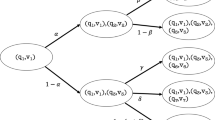Abstract
Many important concepts of the calculus are difficult to grasp, and they may appear epistemologically unjustified. For example, how does a real function appear in “small” neighborhoods of its points? How does it appear at infinity? Diagrams allow us to overcome the difficulty in constructing representations of mathematical critical situations and objects. For example, they actually reveal the behavior of a real function not “close to” a point (as in the standard limit theory) but “in” the point. We are interested in our research in the diagrams which play an optical role –microscopes and “microscopes within microscopes”, telescopes, windows, a mirror role (to externalize rough mental models), and an unveiling role (to help create new and interesting mathematical concepts, theories, and structures). In this paper we describe some examples of optical diagrams as a particular kind of epistemic mediator able to perform the explanatory abductive task of providing a better understanding of the calculus, through a non-standard model of analysis. We also maintain they can be used in many other different epistemological and cognitive situations.
Similar content being viewed by others
References
C. Boutilier V. Becher (1995) ArticleTitleAbduction as Belief Revision Artificial intelligence 77 43–94 Occurrence Handle10.1016/0004-3702(94)00025-V
T. Bylander D. Allemang M.C. Tanner J.R. Josephson (1991) ArticleTitleThe Computational Complexity of Abduction Artificial Intelligence 49 25–60 Occurrence Handle10.1016/0004-3702(91)90005-5
E. Hutchins (1995) Cognition in the Wild MIT Press Cambridge, MA
H.J. Keisler (1976a) Elementary Calculus Prindle Weber and Schmidt
H.J. Keisler (1976b) Foundations of Infinitesimal Calculus Prindle, Weber and Schmidt Boston
L. Magnani (1999) Model-Based Creative Abduction L. Magnani N.J. Nersessian P. Thagard (Eds) Model-Based Reasoning in Scientific Discovery Kluwer Academic/Plenum Publishers New York 219–238
L. Magnani (2001) Abduction, Reason, and Science. Processes of Discovery and Explanation Kluwer Acedemic/Plenum Publishers New York
L. Magnani (2002) Epistemic Mediators and Model-Based Discovery in Science L. Magnani N.J. Nersessian (Eds) Model-Based Reasoning: Science, Technology,Values KluwerAcademic/PlenumPublishers NewYork 305–329
N.J. Nersessian (1995a) ArticleTitleOpening the Black Box: Cognitive Science and History of Science Osiris 10 194–211 Occurrence Handle10.1086/368749
N.J. Nersessian (1995b) ArticleTitleShould Physicists Preach What They Practice? Constructive Modeling in Doing and Learning Physics Science and Education 4 203–226 Occurrence Handle10.1007/BF00486621
D. Norman (1993) Things that Make Us Smart. Defending Human Attributes in the Age of the Machine Addison-Wesley Reading, MA
Peirce, C.: 1931–1958, Collected Papers, C. Hartshorne and P. Weiss (eds.) (vols. I–VI), and A.W. Burks (ed.) (vols. VII–VIII). Cambridge, MA: Harvard University Press.
A. Robinson (1966) Non-Standard Analysis North Holland Amsterdam
K.D. Stroyan (1972) Uniform Continuity and Rates of Growth of Meromorphic Functions W.J. Luxemburg A. Robinson (Eds) Contributions to Non- Standard Analysis North-Holland Amsterdam 47–64
K.D. Stroyan W.A.J. Luxemburg (1976) Introduction to the Theory of Infinitesimals Academic Press New York
D. Tall (1982) ArticleTitleElementary Axioms and Pictures for Infinitesimal Calculus Bulletin of the IMA 18 43–48
Tall D. 2002, Natural and Formal Infinities. To appear in Educational Studies in Mathematics.
P. Thagard (1992) Conceptual Revolutions Princeton University Press Princeton, N.J.
Trafton, J., Trickett, S. and Mintz, F.: 2002, Connecting Internal and External Representations: Spatial Transformations of Scientific Visualizations. Foundations of Science.
J. Zhang (1997) ArticleTitleThe Nature of External Representations in Problem Solving Cognitive Science 21 IssueID2 179–217 Occurrence Handle10.1016/S0364-0213(99)80022-6
Author information
Authors and Affiliations
Corresponding author
Rights and permissions
About this article
Cite this article
Magnani, L., Dossena, R. Perceiving the Infinite and the Infinitesimal World: Unveiling and Optical Diagrams in Mathematics. Found Sci 10, 7–23 (2005). https://doi.org/10.1007/s10699-005-3003-8
Issue Date:
DOI: https://doi.org/10.1007/s10699-005-3003-8




